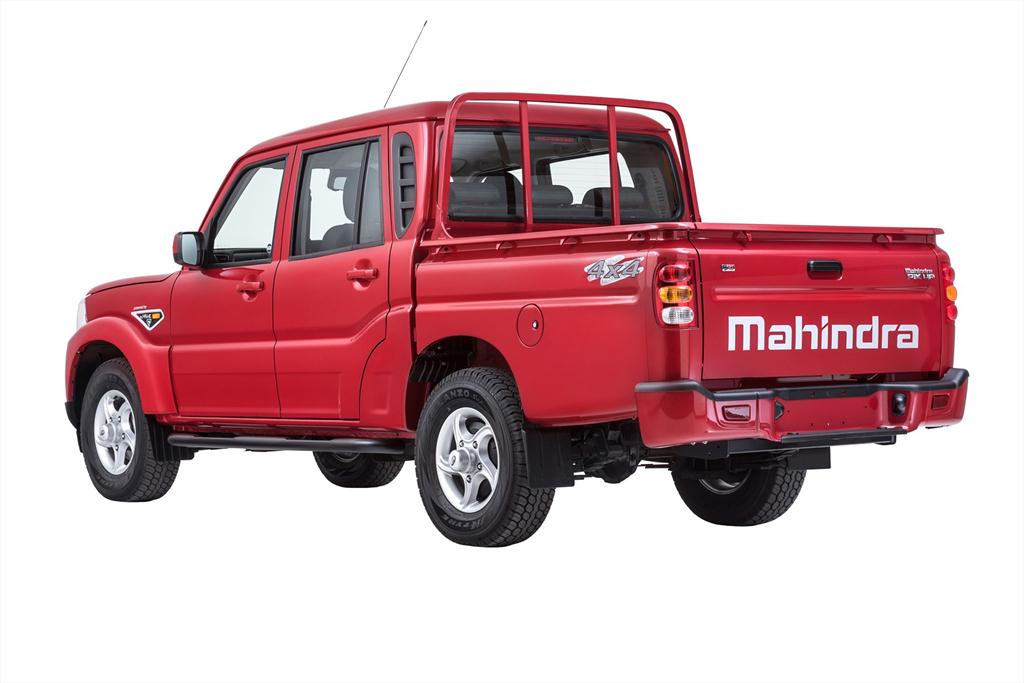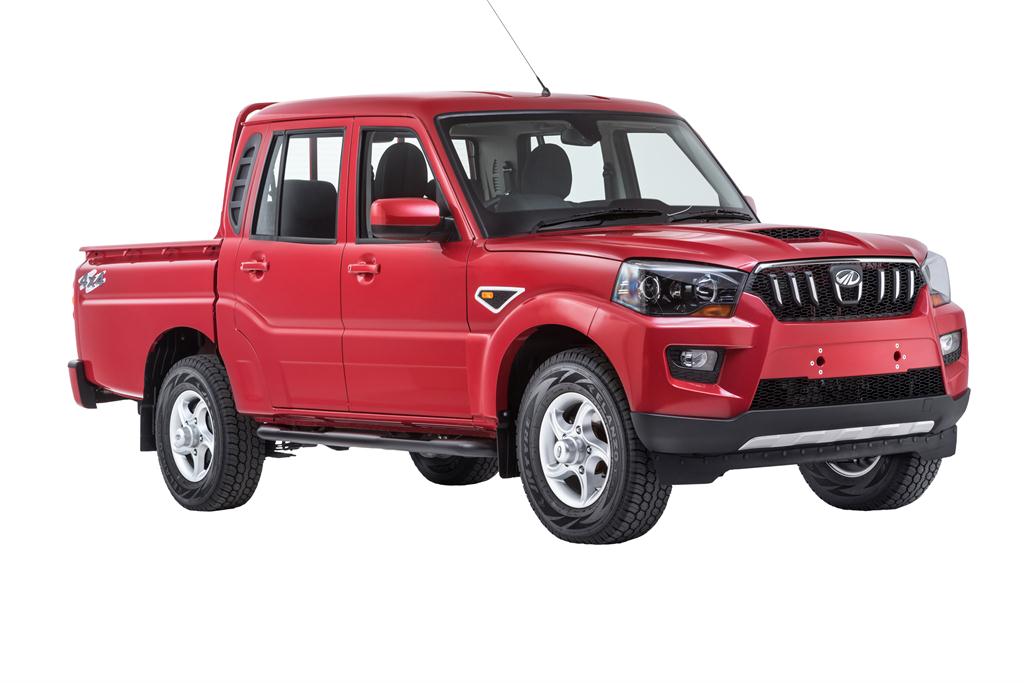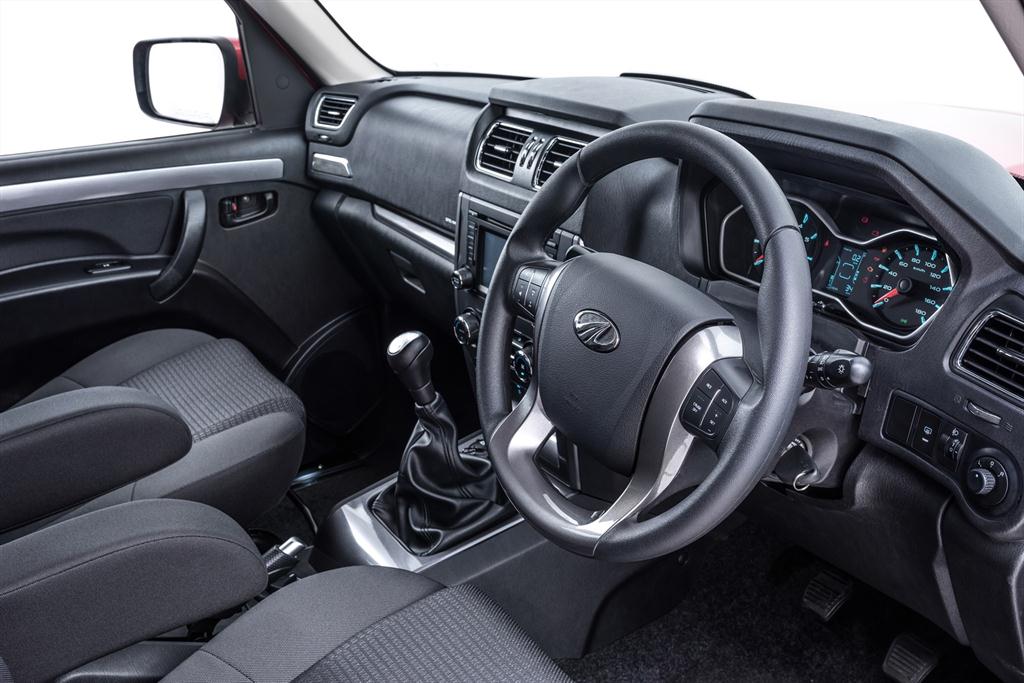Has Mahindra's Pik Up modernised enough?
Mahindra's Scorpio one-tonner has been around for a few years as a more budget-oriented choice in the bakkie 'B-league', targeting buyers who don't have over half a million rand to spend on a well-specced double cab of the Hilux/Ranger/Isuzu ilk.
The price saving came with a rather downmarket feel and mediocre power however - issues which the Indian brand has addressed in the vehicle's recent upgrade and facelift.
As before there's a 2.2-litre turbodiesel under the bonnet, but a new turbocharger has liberated much healthier power and torque outputs: from 89kW and 290Nm to 103kW and 320Nm.
To go with its bigger muscles the bakkie gets a face job in the form of modern new LED “eyebrow” headlights and a prominent bonnet scoop. Pretty it isn't, and it still looks more like an agricultural workhorse than leisure bakkie, but the facelift does arguably make the front end more stylistically palatable.
INTERIOR
The more important change is inside the cabin which is now a more pleasant place to spend time in, courtesy of a modernised dashboard and classier-looking black upholstery for the seats.
Mahindra also dropped the Scorpio name to avoid possible lawsuits when it plans to launch its bakkies in the US, as Ford owns the Scorpio badge there. From now on Mahindra's bakkie is called the Pik Up locally, and it's offered in three grades: the S4, S6 and S10.
On test here is the range-topping S10 version priced at around N$360 000, which comes standard with a lot of standard luxuries including a touchscreen infotainment system with navigation, cruise control, trip computer, automatic climate control, rain-sensing wipers, electric windows, and Bluetooth phone pairing.
Safety is decent too in the form of ABS brakes and dual front airbags, and all models come with four-year/120 000km warranties and roadside assistance, and a five-year/90 000km service plan.
It's a well loaded spec sheet but has some curious omissions, for instance the steering can only be tilted up or down and has no reach adjustment.
There are some ergonomic missteps with the infotainment too. The touchscreen has small icons that aren't particularly easy to use, and the USB and aux ports are hidden in a nook at the bottom of the dash which makes it tricky to plug in a device without lying on the seat using a torch.
The styling renaissance inside the cockpit has hit the sweet spot though, giving this bakkie less of a blue-collar feel than before. The dashboard plastics are the hard type but they're nicely textured to give the cabin a reasonably modern vibe, and it all seems solidly assembled without making any significant rattles.
The cabin's roomy and four or five tall adults will fit in without unwanted intimacy, while the extra-high ceiling will accept the most extravagant hairstyles or headgear.
ENGINE BOOST
The engine boost has done wonders for this Mahindra's power delivery and driveability. It's a gutsy performer with a broad powerband and minimal turbo lag, making for easy going urban stop-start driving and open-road cruiseability.
The six-speed transmission is a relatively slick-shifting thing, but reverse gear doesn't have enough of a spring loading and it's too easy to accidentally hook reverse instead of first.
Driving this Mahindra is a reasonably smooth and un-tractor-like experience, except for the seismic judder when you switch off the engine. A stop-start fuel saving system helped this big bakkie attain a very respectable 8.1 litres per 100km, and the 80 litre fuel tank fuel tank ensures a handy range of nearly 1000km between forecourt visits.
Towing capacity is rated at 2500kg with braked trailer, or 750kg unbraked.
Mahindra's Pik Up is a proficient offroader with a lofty 210mm ground clearance, and it has four-wheel drive and low range that are selectable at the twist of a dial. Switching from rear-wheel drive to 4x4 mode can be done whilst on the move. For extra mobility in the undergrowth, a rear diff lock engages automatically when one of the back wheels starts losing traction. It's a bumpy experience though. The leaf spring rear suspension is made for carrying heavy cargo (the double cab 4x4 is rated for 995kg) but the ride quality with an unladen load box is harsh, and notably bouncier than the more expensive one-ton bakkies.
The turning circle is also huge, even when in two-wheel drive mode.
VERDICT
Mahindra's Pik Up double cab gets a welcome power boost and modernised interior to give it more of a leisure feel. It has some rough edges, most notably its bumpy ride and some ergonomic quirks, but these might more easily be overlooked at the price. It costs at least 80 grand less than similarly powered premium double cab 4x4s from the Toyota Hilux, Isuzu KB and Ford Ranger stables, and is also well priced against most Chinese bakkies in its sub-segment. – iol.co.za
The price saving came with a rather downmarket feel and mediocre power however - issues which the Indian brand has addressed in the vehicle's recent upgrade and facelift.
As before there's a 2.2-litre turbodiesel under the bonnet, but a new turbocharger has liberated much healthier power and torque outputs: from 89kW and 290Nm to 103kW and 320Nm.
To go with its bigger muscles the bakkie gets a face job in the form of modern new LED “eyebrow” headlights and a prominent bonnet scoop. Pretty it isn't, and it still looks more like an agricultural workhorse than leisure bakkie, but the facelift does arguably make the front end more stylistically palatable.
INTERIOR
The more important change is inside the cabin which is now a more pleasant place to spend time in, courtesy of a modernised dashboard and classier-looking black upholstery for the seats.
Mahindra also dropped the Scorpio name to avoid possible lawsuits when it plans to launch its bakkies in the US, as Ford owns the Scorpio badge there. From now on Mahindra's bakkie is called the Pik Up locally, and it's offered in three grades: the S4, S6 and S10.
On test here is the range-topping S10 version priced at around N$360 000, which comes standard with a lot of standard luxuries including a touchscreen infotainment system with navigation, cruise control, trip computer, automatic climate control, rain-sensing wipers, electric windows, and Bluetooth phone pairing.
Safety is decent too in the form of ABS brakes and dual front airbags, and all models come with four-year/120 000km warranties and roadside assistance, and a five-year/90 000km service plan.
It's a well loaded spec sheet but has some curious omissions, for instance the steering can only be tilted up or down and has no reach adjustment.
There are some ergonomic missteps with the infotainment too. The touchscreen has small icons that aren't particularly easy to use, and the USB and aux ports are hidden in a nook at the bottom of the dash which makes it tricky to plug in a device without lying on the seat using a torch.
The styling renaissance inside the cockpit has hit the sweet spot though, giving this bakkie less of a blue-collar feel than before. The dashboard plastics are the hard type but they're nicely textured to give the cabin a reasonably modern vibe, and it all seems solidly assembled without making any significant rattles.
The cabin's roomy and four or five tall adults will fit in without unwanted intimacy, while the extra-high ceiling will accept the most extravagant hairstyles or headgear.
ENGINE BOOST
The engine boost has done wonders for this Mahindra's power delivery and driveability. It's a gutsy performer with a broad powerband and minimal turbo lag, making for easy going urban stop-start driving and open-road cruiseability.
The six-speed transmission is a relatively slick-shifting thing, but reverse gear doesn't have enough of a spring loading and it's too easy to accidentally hook reverse instead of first.
Driving this Mahindra is a reasonably smooth and un-tractor-like experience, except for the seismic judder when you switch off the engine. A stop-start fuel saving system helped this big bakkie attain a very respectable 8.1 litres per 100km, and the 80 litre fuel tank fuel tank ensures a handy range of nearly 1000km between forecourt visits.
Towing capacity is rated at 2500kg with braked trailer, or 750kg unbraked.
Mahindra's Pik Up is a proficient offroader with a lofty 210mm ground clearance, and it has four-wheel drive and low range that are selectable at the twist of a dial. Switching from rear-wheel drive to 4x4 mode can be done whilst on the move. For extra mobility in the undergrowth, a rear diff lock engages automatically when one of the back wheels starts losing traction. It's a bumpy experience though. The leaf spring rear suspension is made for carrying heavy cargo (the double cab 4x4 is rated for 995kg) but the ride quality with an unladen load box is harsh, and notably bouncier than the more expensive one-ton bakkies.
The turning circle is also huge, even when in two-wheel drive mode.
VERDICT
Mahindra's Pik Up double cab gets a welcome power boost and modernised interior to give it more of a leisure feel. It has some rough edges, most notably its bumpy ride and some ergonomic quirks, but these might more easily be overlooked at the price. It costs at least 80 grand less than similarly powered premium double cab 4x4s from the Toyota Hilux, Isuzu KB and Ford Ranger stables, and is also well priced against most Chinese bakkies in its sub-segment. – iol.co.za






Comments
Namibian Sun
No comments have been left on this article